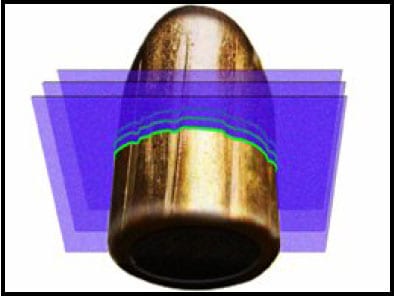Ballistic imaging technology can be a useful tool in the investigation of crimes committed with firearms. As currently used, forensic experts are able to electronically scan into a database a shell casing(s) recovered from a crime scene to determine if those case(s) match those from other crime scenes. The technology can serve as a starting point in assisting law enforcement in determining if the same firearm was involved in multiple crimes.
The federal government has worked for nearly 10 years on developing an imaging network. The National Integrated Ballistic Information Network (NIBIN), administered by the Bureau of Alcohol, Tobacco, and Firearms (BATF), provides federal, state, and local law enforcement officials with critical ballistics information on crimes committed with a firearm. This system matches shell casings recovered from crime scenes to ascertain if a firearm has been used in multiple assaults. By focusing strictly on cases recovered from crime scenes, NIBIN can not be used to build a database of firearms owners thereby guaranteeing the security and legal rights of millions of Americans who are law-abiding gun owners.
How Does it Work?
When a firearm is discharged, both the shell casing and the bullet traveling down the barrel of the gun are imprinted with distinctive marks. The bullet takes on marks from the barrel’s rifling, and the casing is marked by the gun’s breech face, firing pin and shell ejector mechanism (Note: This depends on the type of firearm used. Some guns, such as revolvers or single-shot rifles might not leave ejection marks.) These imprints are distinctive to a firearm. A ballistic imaging program can run a casing through its database and select those that offer a close match. A final identification is made visually by a highly trained ballistic examiner. This process does not lend itself to examining bullets from a firearm. Often, bullets are severely damaged on impact. Bullets recovered are usually examined visually by experts.
Is this “Ballistic DNA” or “Ballistic Fingerprinting”?
Absolutely not. Unlike DNA or fingerprints that do not change over time, the unique marks that can identify a particular bullet or shell casing change due to a number of environmental and use factors. Barrels and operating parts of firearms change with use, wear and tear over time. Moreover, a person can, within minutes, use a file to scratch marks in a barrel or breech face, or replace a firing pin, extractor, and barrel thereby giving a firearm a completely “new” ballistic identity. Imaging remains a tool, but not a silver bullet, in criminal investigations.
What about a National Ballistic Imaging Database?
The creation of a national database that would store ballistic images from all firearms sold would involve huge costs to the government, firearms manufacturers, and customers. It raises questions about a legal “chain of evidence” (i.e., how to handle and store hundreds of millions of bullets or shell casings without exposing all such evidence to attack by defense lawyers), possibly break existing law by creating a database of legal firearms owners, and prove much less effective than NIBIN.
A recent study completed by the California Department of Forensic Services on creating a statewide ballistic imaging network stated that: “When applying this technology to the concept of mass sampling of manufactured firearms, a huge inventory of potential candidates will be generated for manual review. This study indicates that this number of candidate cases will be so large as to be impractical and will likely create logistic complications so great that they can not be effectively addressed.” The study pointed out that when expanding the database of spent shell casings, the system will generate so many “hits” that could be potential matches, it would not be of any use to forensic examiners. Other problems included guns making different markings on casings from different ammunition manufacturers; the shipping, handling, and storage of spent shell casings; some firearms do not leave marks that can be traced back to that particular firearm; and the system demands highly-trained personnel for proper operation.
Maryland and New York Ballistic Imaging Programs
Maryland introduced its own ballistic imaging system in 2000. Every new handgun that is sold in the state must be accompanied by spent shell casings for input into the imaging network. According to Maryland budget figures, approximately $5 million has been spent on the system. According to Maryland law enforcement officials, it contains over 11,000 imaged cartridges, has been queried a total of 155 times and has not been responsible for solving any crimes.
In New York, there have been thousands of cartridges entered into their database and, according to reports, no traces have resulted in criminal prosecutions.
Guns in Private Hands
There are an estimated 260 million firearms in private hands. It would be virtually impossible to retrieve these firearms for ballistics documentation without violating the constitutional rights of millions of law abiding firearms owners.
How Best to Use Ballistic Imaging Technology
There is a proposal in Congress, the Ballistic Imaging Evaluation and Study Act, introduced in both the House and Senate (by Representative Melissa Hart, R-PA, and Senator Zell Miller, D-GA) that orders the Department of Justice to contract for a study by the National Academy of Sciences, which would examine the many questions surrounding imaging technology and provide a list of recommendations to policymakers and Congress. Enacting the legislation to begin this study is a priority. The proper allocation of funds to fight crime is critical to ensuring safe communities. The study outlined in the legislation will provide firm scientific conclusions on which to base decisions on how best to deploy this technology.
Miles E. Hall
Founder & President
H&H Shooting Sports Complex
I-40 & Meridian
400 South Vermont, Suite 110
Oklahoma City, Oklahoma 73108-1034
(405) 947-3888 ext.111



